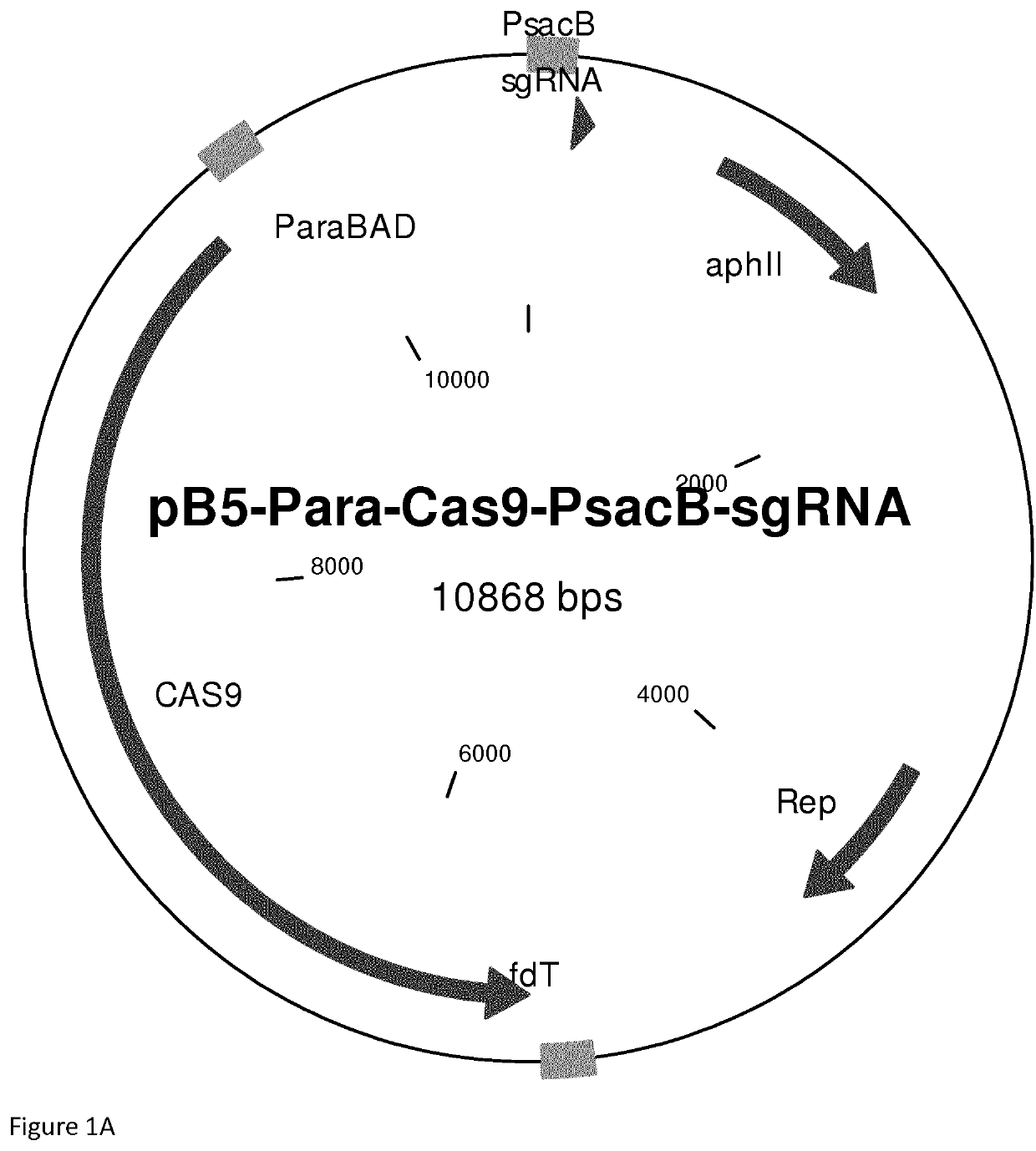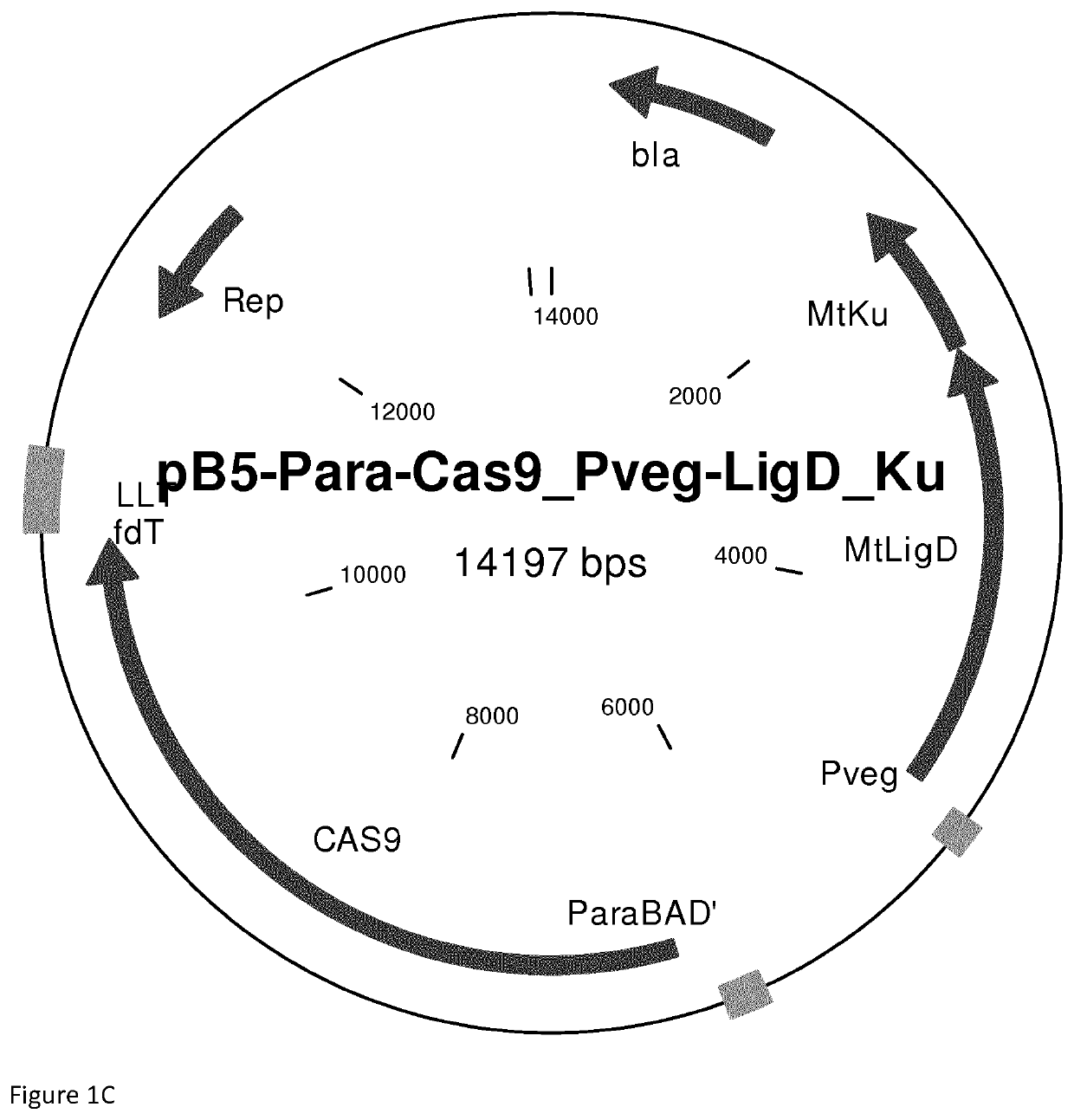Reconstitution of dna-end repair pathway in prokaryotes
a dna-end repair and prokaryotic technology, applied in the field of prokaryotic genome targeted modification, can solve the problem of almost complete lack of viable i, achieve the effect of reducing the toxicity of cas9-induced genomic dna breaks, reducing the toxicity of self-targeting cas9-sgrna complexes, and showing the adaptability of our system
- Summary
- Abstract
- Description
- Claims
- Application Information
AI Technical Summary
Benefits of technology
Problems solved by technology
Method used
Image
Examples
example 1
[0056]As shown in FIG. 2 the presence of Ku-LigD promotes the repair of DSB induced by Cas9 loaded with self-targeting sgRNA in A. vinelandii. Isolation of clones and sequencing of the targeted region showed a specific Cas9-induced DNA a break 3-nt upstream of the PAM sequence, exonucleolytic degradation and ligation of the DNA-ends as depicted in FIG. 3.
[0057]More particularly FIG. 2 shows:[0058](A) A. vinelandii transformed with the plasmid pB5-Para-Cas9-PsacB-sgRNA-empty coding for Cas9 and a sgRNA without specific guide sequence. The transformants were plated on an agar plate containing Kanamycin.[0059](B) As in (A) but transformed with the plasmid pB5-Para-Cas9-PsacB-sgRNA-uppS5 that codes for Cas9 and sgRNA targeting the upp gene.[0060](C) As in (B) but transformed with the plasmid pB5-Para-dCas9-PsacB-sgRNA-uppS5 that codes for catalytically inactive Cas9 and sgRNA targeting the upp gene.[0061](D) As in (B) but transformed with the plasmid pB5-CLK_PsacB-sgRNA-uppS5 that encod...
example 2
[0064]As shown in FIG. 4 the presence of Ku-LigD promotes the repair of DSB induced by Cas9 loaded with self-targeting sgRNA in P. putida.
[0065]More particularly FIG. 4 shows:[0066](A) P. putida transformed with the plasmid pB5-Para-Cas9-PsacB-sgRNA-uppS15 encoding Cas9 and sgRNA targeting the upp gene.[0067](B) As in (A) but transformed with the plasmid pB5-CLK_PsacB-sgRNA-uppS5 that encodes Cas9-MtLigD-MtKu and sgRNA targeting upp gene.
[0068]The delivery of said plasmids into P. putida was achieved by conjugation using E. coli S17-1λpir as donor cells.
example 3
[0069]The presence of Ku and LigD from M. tuberculosis reduces the toxicity of self-targeting Cas9 nuclease in E. coli MG1655 (FIG. 5) and enables efficient introduction of NHEJmutations as shown in FIGS. 6 and 7.
[0070]More particularly FIG. 5 shows:
[0071]Chemically competent E. coli MG1655 was transformed either with pB5-Para-Cas9-PsacBsgRNA-bgaI or pB5-CLK_PsacB-sgRNA-bgaI. Both vectors encode wildtype Cas9 and a sgRNA targeting the lacZ gene. The vector pB5-CLK_PsacB-sgRNA-bgaI also expresses the proteins LigD and Ku from M. tuberculosis. The transformants were plated on selective agar plates and the numbers of colony forming units were determined.
[0072]FIG. 6 shows:
[0073]Chemically competent E. coli MG1655 were transformed either with pB5-Para-Cas9_PvegLigD_Ku or pB5-Para-Cas9_Pveg-LigD_PsacB_Ku. Both vectors encode wildtype Cas9, a sgRNA targeting the lacZ gene and express the proteins LigD and Ku from M. tuberculosis. Single colonies of the transformants were cultivated for pr...
PUM
| Property | Measurement | Unit |
|---|---|---|
| time | aaaaa | aaaaa |
| LENGTH | aaaaa | aaaaa |
Abstract
Description
Claims
Application Information
 Login to View More
Login to View More - R&D
- Intellectual Property
- Life Sciences
- Materials
- Tech Scout
- Unparalleled Data Quality
- Higher Quality Content
- 60% Fewer Hallucinations
Browse by: Latest US Patents, China's latest patents, Technical Efficacy Thesaurus, Application Domain, Technology Topic, Popular Technical Reports.
© 2025 PatSnap. All rights reserved.Legal|Privacy policy|Modern Slavery Act Transparency Statement|Sitemap|About US| Contact US: help@patsnap.com



